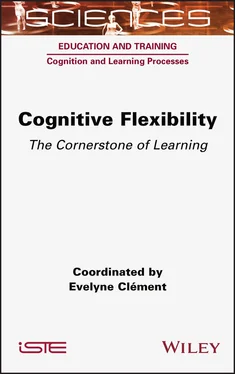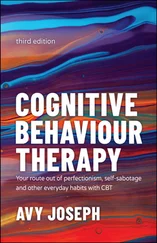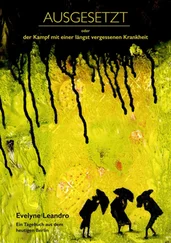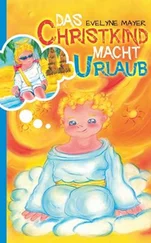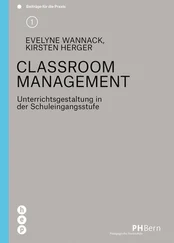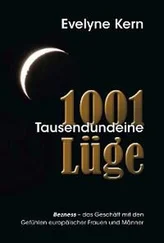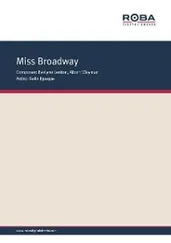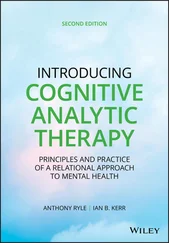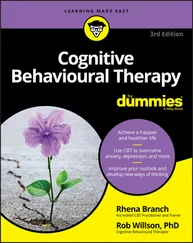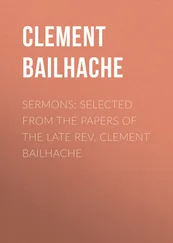Evelyne Clement - Cognitive Flexibility
Здесь есть возможность читать онлайн «Evelyne Clement - Cognitive Flexibility» — ознакомительный отрывок электронной книги совершенно бесплатно, а после прочтения отрывка купить полную версию. В некоторых случаях можно слушать аудио, скачать через торрент в формате fb2 и присутствует краткое содержание. Жанр: unrecognised, на английском языке. Описание произведения, (предисловие) а так же отзывы посетителей доступны на портале библиотеки ЛибКат.
- Название:Cognitive Flexibility
- Автор:
- Жанр:
- Год:неизвестен
- ISBN:нет данных
- Рейтинг книги:4 / 5. Голосов: 1
-
Избранное:Добавить в избранное
- Отзывы:
-
Ваша оценка:
- 80
- 1
- 2
- 3
- 4
- 5
Cognitive Flexibility: краткое содержание, описание и аннотация
Предлагаем к чтению аннотацию, описание, краткое содержание или предисловие (зависит от того, что написал сам автор книги «Cognitive Flexibility»). Если вы не нашли необходимую информацию о книге — напишите в комментариях, мы постараемся отыскать её.
Cognitive Flexibility — читать онлайн ознакомительный отрывок
Ниже представлен текст книги, разбитый по страницам. Система сохранения места последней прочитанной страницы, позволяет с удобством читать онлайн бесплатно книгу «Cognitive Flexibility», без необходимости каждый раз заново искать на чём Вы остановились. Поставьте закладку, и сможете в любой момент перейти на страницу, на которой закончили чтение.
Интервал:
Закладка:
The local-global task (Miyake et al . 2000) presents a geometric figure (often referred to as a “Navon figure”; Navon (1977)), in which the shape of a global figure (e.g. a triangle) is composed of other figures, local figures this time, which are much smaller (e.g. squares). A cue (e.g. the color of the figure) tells participants whether to give the number of lines used to compose the figure (e.g. 1 for a circle, 2 for an X, 3 for a triangle, or 4 for a square) for either the global figure or the local figure.
Like the two tasks just presented, some tasks are qualified as cueing, as a cue (usually visual or auditory) signals to the participant what processing they should perform on the stimuli presented to them. For example, in the Color Shape Task (Miyake and Friedman 2012), a cue is given to the participant (C or S) to indicate whether they will have to judge the color (C for color, red or green) or the shape (S for shape, circle or triangle) of the stimulus that will appear. The switching cost is calculated by comparing the reaction times between repeated items (when the processing of the presented item is the same as for the previous item, color then color, for example) and switching items (when the processing of the presented item is different from the previous item, color then shape, for example).
In the TMT (Reitan and Wolfson 1993), the participant must switch from processing a sequence of letters in alphabetical order (A, B, C, etc.) to processing a sequence of numbers in ascending order (1, 2, 3, etc.), alternating between the two processes from one item to the next. Several numbers and letters are placed on a sheet of paper and the participant has to connect the elements with a pencil, going from the first letter (A), to the first number (1), to the second letter (B), and so on (A, 1, B, 2, C, 3, etc.).
A simplified version of this test exists to make it accessible to preschoolers, the TMT for preschoolers (Espy and Cwik 2004). In this test, a sheet of paper shows dogs and bones of different sizes. The child is asked to stamp dogs in order of size (smallest to largest), while stamping the bones corresponding to the size of the dog as they go. The child must stamp the smallest dog, then the smallest bone, then the second dog, the second bone, etc. However, this version for children does not seem quite satisfactory, at least if it is to be used in conjunction with the adult version, because it does not allow for the same type of change to be assessed. The adult version requires switching from one task to another (connecting numbers and connecting letters), whereas the child version only proposes switching between two identical tasks: connecting according to size, certainly by alternating dog and bone, but the task remains identical.
Another adult version with a version for children exists: the Color Trail Test (CTT) (D’Elia et al. 1996) and the Children’s Color Trail Test (CCTT) (Williams et al. 1995), this time being more similar to the adult version. In both cases, the test consists of alternating between two series of numbers, one in pink circles, the other in yellow circles. These versions are simpler than the original version, proposing to alternate between two identical tasks (connecting the sequence of numbers, although alternating according to the color of the items). However, they are still useful in some cases and have the advantage of proposing two equivalent versions, allowing for a comparison of the results of children and adults.
1.3.1.1.2. Executive function assessment batteries
Direct assessments are often less used by practitioners than by researchers, due to the greater material and temporal cost than for indirect assessments. However, there are several batteries of executive function assessments that include measures that can be likened to measures of cognitive flexibility, which have the advantage of providing useful calibrations for practitioners.
The Test of Everyday Attention for Children (TEA-Ch) (Manly et al . 2001), which assesses the attentional abilities of children aged 6 to 12 years, includes the Creature Counting subtest, which can be used to assess cognitive flexibility. In this test, the task is to switch from counting up to the creature to counting down based on explicit visual cues (arrows indicating the counting direction). If the arrow points up, count upwards, but if the arrow points down, count backwards. This test involves flexibly switching from one process to another several times during the test.
Another battery that includes possible flexibility assessments is the developmental neuropsychological assessment, second edition (NEPSY II) (Korkman et al. 2012), intended for children aged 5 to 16 years and 11 months. This battery includes the drawing fluency subtest (also usable for children aged 5 to 16 years and 11 months), in which the child is asked to connect dots in different ways by drawing lines in a limited time. Flexibility is assessed here by the child’s ability to produce different “drawings” for each item and to produce as many as possible within the time limit. As the name implies, this task is also often not considered a flexibility task, but a fluency task.
A second subtest of the NEPSY II could be related to a measure of flexibility: it is the categorization subtest that can be used for children aged 7 to 16 years and 11 months. In this subtest, the child must produce categories to sort cards showing pictures that can be grouped in different ways. For example, the cards show animals of different sizes (large versus small), on different colored backgrounds (blue versus yellow), etc. The child is given an initial categorization by the adult and is then asked to produce others. This subtest can be used to assess cognitive flexibility, as it involves producing several different sorting actions for the same material.
We can also mention a verbal fluency test that can be used to measure flexibility (spontaneous flexibility in particular): the switching part of the verbal fluency test of the Delis-Kaplan Executive Function System (D-KEFS) (Delis et al. 2001). This battery can assess the executive functions of participants aged 8 to 89. One of the subtests can also be used as a measure of flexibility: the switching part of verbal fluency. After the fluency part, where the person has to give as many words as possible on the basis of a semantic or phonological primer, the person is asked to alternate the propositions between two different semantic categories.
These four subtests could therefore all be considered as assessing, or at least partly involving, cognitive flexibility, but none of the four are explicitly described as such, and to our knowledge, there is no cognitive or executive test battery that includes an assessment of cognitive flexibility named as such.
1.3.1.1.3. More playful tasks
Whether in practice or in research, we may wish to use more playful situations to assess flexibility, depending on the age or specificity of the participants. The following two situations, for example, can be used for this purpose.
The innovation paradigm consists of asking the child to draw an object that does not exist (Karmiloff-Smith 1990). The child must first draw objects that really exist (house, man, animal) and then draw these same objects, but also those that do not exist in our world (Picard and Vinter 2005). Young children (4 to 6 years) make intracategorical changes, that is, they only change the size or shape of the object itself, without introducing intercategorical changes. These changes appear later (8 to 10 years) and correspond to the introduction of an element of one category (the wings of a bird for example) on a drawing of another category (a house).
Another fun way to assess flexibility in young children, for example, is to use a drawing of a character starting with the foot (Baldy 2010) to assess the possibility of switching to another procedure in a flexible way. This involves slowing down the routine of drawing a man, which usually always starts with the head, by requiring the child to start the drawing with one of the man’s feet.
Читать дальшеИнтервал:
Закладка:
Похожие книги на «Cognitive Flexibility»
Представляем Вашему вниманию похожие книги на «Cognitive Flexibility» списком для выбора. Мы отобрали схожую по названию и смыслу литературу в надежде предоставить читателям больше вариантов отыскать новые, интересные, ещё непрочитанные произведения.
Обсуждение, отзывы о книге «Cognitive Flexibility» и просто собственные мнения читателей. Оставьте ваши комментарии, напишите, что Вы думаете о произведении, его смысле или главных героях. Укажите что конкретно понравилось, а что нет, и почему Вы так считаете.
